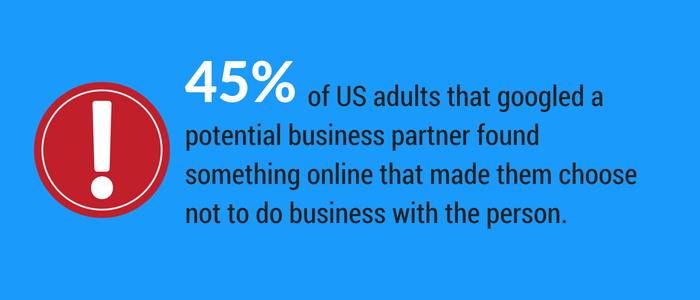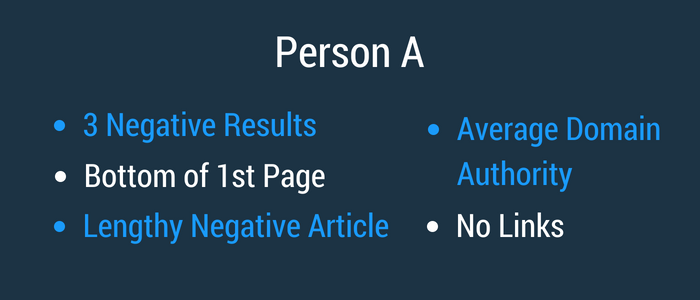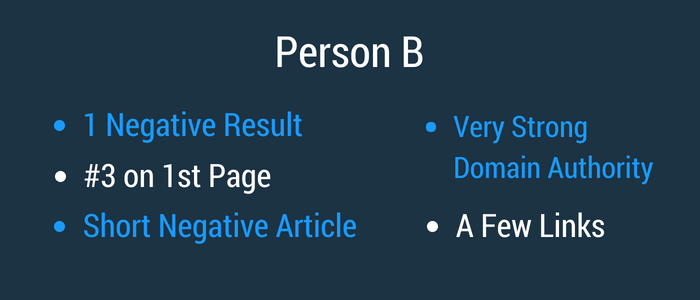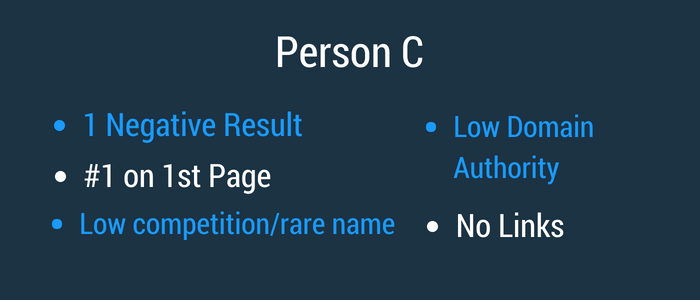Online Reputation Repair: How Long It Takes & What To Expect
It’s time to set the record straight.
When it comes to online reputation repair, there are a ton of myths floating around that simply aren’t true.
We know this because every day we talk to potential clients and customers who’ve bought into them.
These myths aren’t based on facts at all. Instead, they’re created by ORM “consultants” who take advantage of vulnerable people willing to do anything to repair their online reputation.
These scammers use lies to sell their online reputation repair services by preventing potential clients from understanding the process of online reputation management.
Want to know the most common ORM falsehood out there?
The claim that your problems can be fixed “overnight”.
If you hear someone pitch this idea to you, RUN. Of course, the thought of this is incredibly appealing. But this person claiming that they can make this happen is either lying to your face, or using unsavory tactics to make short-term gains.
By operating outside of industry-set standards for search engine optimization, the problem will actually get much worse for you in the long-run.
Online reputation repair is an ongoing process that takes time and effort. There’s no way around it. This is frustrating to hear when dealing with search results that damage your online reputation.
We understand why people seek out fast-fix solutions. But to effectively rebuild your online reputation, you must be willing to commit your time and follow best-practices.

Now that you know that any indication of “overnight success” is a scam, you should be better equipped to separate good companies and individuals from shady ones.
However, we want to make sure you have all the information that you need when it comes to understanding how online reputation repair works (and how it doesn’t).
That’s why we decided to outline the key information you need to know when it comes to the process of repairing your online reputation. In this guide we’ll cover:
- What to expect when it comes to online reputation repair.
- Realistic timelines for when you’ll see changes (these will vary based on you).
- Examples of different reputation repair scenarios.
- Further steps you can take to repair your reputation online.
By thoroughly understanding the process, you’ll be able to accurately vet a company or consultant you want to work with. Make sure to ask relevant questions when it comes to considering different companies.
If they brush off your questions or refuse to be transparent about their process, then you should look elsewhere for help with repairing how you look online.
Is it possible to truly repair your online reputation?
When asking yourself or an ORM (Online Reputation Management) company whether or not you can truly repair your online reputation, remember, the answer is yes.
Even if you are dealing with authoritative or persistent negative results, don’t lose hope. Instead, put in the work and the time.
While the specifics of every situation are different, the best route to true online reputation repair is through the process of building an optimized foundation, removing any negative content you control, establishing credibility & an audience, and targeting growth opportunities.
The reason that we suggest that you follow this process (instead of just trying to remove a negative, or clicking “publish” a million times), is because it addresses your online reputation holistically.
We want to make sure that you use this as an opportunity to build a personal brand that wins you opportunities and actually makes you proud. We don’t want this to just be an exercise in burying a search result that you find unflattering.

By taking control of your own brand narrative in a consistent way that follows best (SEO & branding) practices, you are setting up a long-term solution. Yes, flooding websites and profiles that you control with positive information about yourself will help users see a complete picture of who you are. But that’s just one aspect of repairing your reputation.
And before fully getting to the “how” of improving your online appearance, you need to first get a better understanding of what “success” means.
What does online reputation repair look like?
“Zero negative search results” is probably your gut reaction to this question. And we understand that thought process. However, that’s not really success.
“Zero negative search results” doesn’t take into account what people looking you up will consider to be a win. A lack of negative search results ignores the need for positive search results.

But consider this, 56% of US adults that googled a potential partner found something in an online search that solidified their decision to do business with that person. This means that it’s not enough to hide negative results. You must have search results that accentuate your skills in order for your online reputation to help you.
Additionally, by stating, “zero negative search results” as your definition of online repair, you may end up hiring an unqualified consultant who ultimately hurts your reputation in the long-run (as mentioned above).
In today’s day and age it’s not about deleting your past from the internet, it’s about showcasing your attributes. This means that online reputation repair is less about cleanup and more about positive promotion.
Because successful removal requests are often difficult to achieve, building and optimizing content that you control is the best way to address a negative search result.
While ultimately the hope is that your content is so engaging and well-received that it suppresses negative results farther down in rankings, this is a process that requires ongoing attention. The time that it takes to gain control of your search results depends on a number of factors.
Some people will see rapid changes in rankings and others will witness more measured shifts in search results. Regardless of the speed of initial changes in search engine rankings, the most important thing to do is to focus on the content and activity that you can control.
Show other users that you are an authority in your industry with the type of content that you publish. Devote time to engaging with others in your field on different social media platforms.
By being accessible, engaged and a part of current discussions, you have the chance to expose the truth behind what kind of person and professional you actually are.
How long will it take?
When it comes to online reputation repair, there is no exact timeline. However, Google normally recognizes changes in indexed sites and profiles every 2 to 6 weeks.
But don’t let that number fool you. This doesn’t mean that all your sites or profiles will automatically shoot up to the top of the first page of search results a month or so after you create them.
Depending on your particular situation, you may begin to see small changes in rankings as early as a few months after building and optimizing your site and profiles, to well over a year.
Again, it truly depends on factors like: how competitive your search query is, how many negative search results you are dealing with, how old your negative result is, what site your negative search result is coming from, and more.
Let’s use some examples to illustrate how much the timelines can vary:
For these examples let’s assume that Person A, B, and C have zero existing web properties that they control. However, each person is letting the same reputable company handle their online reputation repair.
Below we’ll review each scenario and their estimated timelines for improvement based on that information.

Person A: The Problem
Person A got some bad press a few years ago. Because of this, three negative search results show up when you search their name online. These unflattering search results are all ranking near the bottom of the first page, and are fairly lengthy articles.
The sites that posted these negative articles have average domain authority (read: site strength), but no one has ever linked to or shared these articles.
Person A: The Timeline
The fact that the negative results are older in nature will work in Person A’s favor. Google typically views older content as less relevant than content published more recently. This means that up-to-date, high-quality content has a great chance of making it to the first page.
The length of these offending articles means that it will be important for Person A to create in-depth and lengthy content to overtake the negative results. The fact that the domain authority of these sites isn’t super high and no one has linked to these articles means this is one of the main reasons the negative results are on the first page.
One-upping the negative articles in that regard will set up the content that you’ve written for success.
Based on similar online reputation repair campaigns that we run for clients, this would probably be a campaign that would see most of its significant progress after the six-month mark. And the degree of fluctuation seen in search results could vary at the point depending on a number of factors (those listed above, and others).
Remember that online reputation repair is not an exact science, so even when you’re doing everything correctly, that won’t always translate immediately into search result rankings. That’s why it’s important to give the process time, set up clear metrics for success from the beginning, and consistently work on your strategy and execution.
It takes time to create and promote lengthier content, and with three negative results Person A would need to constantly shift focus and juggle where they devote their time.

Person B: The Problem
Person B has one negative search result about a public incident they had with a cement mixer and their boss’s Lexus. The article is recent and currently ranks at #3 for their name. The site that published information about this unfortunate incident has a very strong domain authority.
However, the article itself is only a 250-word blurb. To add insult to injury, a few people have linked to this particular article.
Person B: The Timeline
This case might seem fairly simple, but there are a number of factors here that make it a tricky one. The domain authority of the site that posted the negative article is probably the most concerning factor here.
Despite the article being on the short side, a strong site can still rank for personal search results very easily - especially for recent events.
The fact that there are a few links to the article is something else to be aware of. Links are a big factor in the Google ranking algorithm and it’s typically pretty tricky for someone without experience to build quality links on their own (a definite benefit of working with an online reputation repair company).
If Person B were to handle this on their own, this would be something they would need to study up on in order to successfully repair their online reputation.
A reason to be optimistic about Person B’s situation is that the negative article is so short. This suggests that there’s an opportunity to create some high-quality content that will help close some of the gap over time.
Given the information above, this would likely be a campaign that took longer to see changes in rankings than the other two. Based on our experience with clients in similar situations, we would expect to see more significant movement after the eight-month mark.
Populating the first page with positive content would most likely take less time, but to fully suppress this negative result would be a time-intensive undertaking for sure.

Person C: The Problem
Person C has one search result they aren’t too fond of that’s currently ranking #1 for their name. It’s a fairly old article, and it didn’t get a lot of traction online. Luckily no one decided to share or link to the result.
Person C has a very uncommon name. That means that the competition and search volume is very low for that keyword (their name). The content of the negative search result is of average length, and the site it’s published on has pretty low domain authority.
Person C: The Timeline
Right off the bat there are some things about this situation that make the outlook very promising. The uncommon name, low competition, and low domain authority give Person C a chance to make a dent on the first page of search results fairly quickly.
But don’t assume that reputation repair for Person C will be a walk in the park. Despite a lot of the favorable metrics, the fact that the negative result is ranking #1 means it needs to be knocked down a full 10 positions (at least) to get it off the first page of results.
Person C will have to pay close attention to a variety of web properties and make sure each of them is well-optimized. The success of this campaign depends more on consistency and discipline than on implementing an overly complicated, high-level strategy.
Given these circumstances, it’s very likely that Person C will influence the first page of results quickly. Populating a handful of the positions on the first page with new, well-optimized web properties would probably start after the two month mark or so of the campaign. From that point on, the strategy should focus on suppression in order to outrank the negative search result.
Don’t let the above time estimates fool you. There’s no easy way to nail down a guaranteed timeline of success when it comes to online reputation repair. There are simply too many factors at play.
Even with the information provided for each of these cases, there are always other factors that could easily impact how long it takes to see changes in ranking. The only way to know 100% is after the completion of a campaign.
That’s why, if you hear firm guarantees in this industry (particularly when it comes to timelines), don’t sign the contract! The best of the best can’t guarantee instant success, so that budget “consultant” certainly can’t either. And you don’t want to end up with an even more damaged online reputation from their shoddy work.
Now, that we’ve laid out the scenarios and the likely timelines for these three cases, let’s talk a bit more about the repair strategy.
Our Reputation Repair Strategy:
At BrandYourself, we follow and encourage our clients to follow particular steps and strategies when it comes to enhancing or repairing their online reputation.
The needs, obstacles and objectives vary with every situation. However, the best route to true online reputation repair is through the process of:
- Building an optimized foundation
- Removing any negative content you control
- Establishing credibility & an audience
- Targeting growth opportunities
We are so thorough in our repair strategy because we know that reputation repair is more than just suppressing the negatives. While negative suppression is a part of reputation repair, this is a chance to build, establish and maintain an online presence that increases your earning potential, professional opportunities and even personal connections.
While the process of reputation repair is ongoing, there are certain markers to pay attention to.
Build an optimized foundation
During the first phase, we suggest that you build properties. By “properties” we mean high-quality social media profiles and a professional-looking website. These should work together to create a robust image of who you are, what you’ve done, where you’re going in your career and how you can be of service to others.

We’ve written extensively on how to build and optimize social media profiles. Here is an example.
Each profile should be fully optimized to rank well for your name and help you repair your online reputation. As you devote your time to these profiles and sites, make sure that they are updated regularly with relevant information.
You also need to engage with other users on these different platforms regularly. From here you should monitor the progress and upkeep of these profiles and sites while keeping an eye on the progress of any other negative or irrelevant content out there about you.
Remove or deindex any damaging content you can
Once you’ve built or optimized the best social media profiles for you, and devoted some time to developing your own personal website, you need to focus on deleting, unpublishing or otherwise taking down any of this content that is damaging your reputation.
We’ve written volumes about dealing with negative search results. We even developed a new feature in our software that lets you hook up your Facebook and Twitter accounts then look up your online reputation score and scan for damaging content.

And some scenarios are easier to deal with than others. For example, removing a photo that you posted of yourself ten years ago where you did a kegstand is easier than say petitioning the removal of an SEC filing against you. However, the rules vary depending on where you are, and the type of negative content that you’re dealing with.
Establish credibility & an audience
Once you’ve created a strong foundation and gotten rid of all the negative content that you can, you must look towards establishing yourself as credible and build an audience. Building an audience requires that you demonstrate your expertise. This demands qualifications like degrees, years of experience, and other licensing certification, but also active engagement in your field today.
Establish your credibility by developing a rapport with influencers, gatekeepers and other thought leaders within your industry. Publish your content on respected platforms, and team up with relevant publishers.
Practicing thought leadership can be incredibly helpful for you. Proving your credibility is a multi-faceted project and you can’t come at it from just one angle. By actively showcasing examples of your credibility you will naturally attract an audience.

However, you need to also push yourself to build a loyal and engaged following. You will certainly build your audience by working with other influential people in your field who appeal to a similar target audience.
You also need to use data to track and monitor the behaviors, likes, dislikes and general engagement of your growing audience. You need to learn as much as you can about your existing audience in order to take informed steps about how to attract more audience members.
Repair your online reputation by growing
As you continue to increase the strength of your online reputation through regularly publishing quality content and engaging with your audience, you’ll start to notice more opportunities coming your way. Some will present themselves directly to you, and others will require you to go out there and get them.
Speaking gigs, promotions, mentorships, grants, new jobs, writing opportunities, etc are all professional opportunities that can start to come to you. Be discerning with what you choose to work on and who you choose to work with through your extended network.
However, if you find the right fit, take advantage. Not only will this help you in an obvious way, but this will also give you more unique high-value content to publish and share. This will likely open you up to an even greater audience online.
By following these steps and staying active, you will slowly begin to repair any past damage done to your online reputation. You will also safeguard your future online presence against damaging search results by creating a strong barrier of optimized properties that you control.
Why is suppression the best method?
While getting a negative search result removed from the internet would be ideal, in truth, the process is very difficult.
Search engines honor a select handful of removal requests, and even when the information is removed or de-indexed, that doesn’t mean that it won’t resurface later on.
Suppression is a long-term solution that enhances your current online identity while protecting your reputation in the future.
In ORM there’s a joke (yes, we do make jokes) that asks, “Where’s the best place to hide a dead body?”
The answer?
“Page 2 of search results”
When it comes to click through rates, the farther down in search result rankings you go, the fewer clicks these sites receive from users. So it should come as no surprise that the number of people clicking through results degrades the higher the page number.
The actual rate is pretty significant. Advanced Web Ranking released a study about the click-through-rate from Google’s organic search results. According to this data, on average, 71.33% of searches resulted in a page one Google organic click. Pages two and three get only 5.59% of the clicks.
While the reality is that your focus should be on creating positive content, take comfort in the fact that suppressing an undesirable search result down 1 spot significantly diminishes the likelihood of users clicking through. And, if you eventually overwhelm a negative search result off of the search page and onto the second, an even greater number of users won’t click it - let alone see it.
For internet reputation repair, instead of focusing on how long it will take to suppress a negative result, work on creating strong sites and profiles that follow best SEO practices and have the greatest shot at ranking well over time.
No matter how damaged your online reputation may seem, there are still steps that you can take to repair it. To scan and diagnose your online reputation, sign up for our online reputation management software.
However, we typically recommend our reputation management services to those dealing with damaged reputations as it takes a lot of work and a customized strategy. Our in-house team of brand strategists, writers and social media specialists are here to help. To learn about your options, give us a call at (646) 863-8226 or schedule a complimentary consultation with a Reputation Advisor.